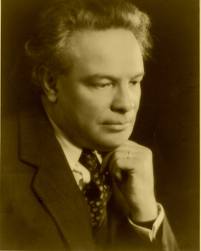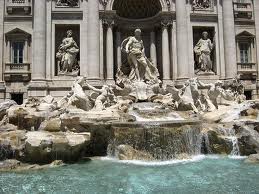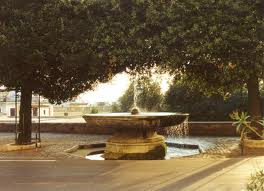July 9, 2012.The Italian composer Ottorino Respighi was born on this day in 1879 in Bologna, Italy.At the end of the 19th century, music in Italy, one of the main European centers two- three hundred years earlier, was pretty much limited to opera.While it’s true that Rossini, Bellini and Donizetti in the first half of the 19th century, and Verdi’s in its second half brought the art of opera to new heights, orchestral and instrumental music, on the other hand, pretty much languished.Ottorino’s father, a piano teacher, taught him to play piano and violin.Respighi continued his studies at the Liceo Musicale in Bologna, and upon graduating, went to Russia: the Imperial Mariinsky Theater was staging a season of Italian operas, and Respighi was hired as the principal violist in the orchestra.While in Saint Petersburg, he studied compositions with Rimsky-Korsakov.Upon returning to Italy he settled in his hometown, composing and concertizing across Italy, but in 1913 was invited to teach composition at the Academy of Santa Cecilia in Rome.He stayed there for the rest of his life.In 1916 he composed Fontane di Roma, a symphonic poem, which eventually became the first part of the “Roman trilogy,” his most famous set of compositions.The second part, Pini di Roma, was written in 1924, and Feste Romane (Roman festivals) – in 1926.
As many of his colleagues (Alfredo Casella comes to mind) Respighi was interested in the old Italian music.He published editions of music of Monteverdi, Vivaldi, and Marcello.Unlike Casella, though, Respighi stayed away from politics and was never enamored with Fascism.He died on April 18, 1936 of the same heart disease that had killed Gustav Mahler 25 years earlier.
Fontane di Roma consists of four parts, each one “describing” a particular fountain during different hours of the day.The first part is called "La fontana di Valle Giulia all'alba," the fountain of Valle Giulia at dawn (Valle Giulia is an area in Rome not far from Villa Borghese).
The second movement is called "La fontana del Tritone al mattino" (The Triton Fountain in the Morning).The famous fountain, in the center of Piazza Barberini, was created by the great sculptor and architect Gian Lorenzo Bernini in 1642.
The third movement is called "La fontana di Trevi al meriggio" (The Trevi Fountain at noon).Probably the most popular of all Roman fountains, it was completed in 1762, but a fountain has existed on that spot from at least 1453.Even during Roman times water flowed there: it was a terminal point of an aqueduct.
The last, fourth movement is called "La fontana di Villa Medici al tramonto" (The Villa Medici fountain at sunset).There are many fountains in the gardens of Villa Medici.Most likely Respighi had in mind the one in front of the villa.The villa, which is adjacent to Villa Borgese, sits on top of the Pincio hill.Overlooking the fountain, there’s a wonderful view of Rome, even though it’s now partly obscured bytrees.
You can listen to Fontane di Romahere.It’s performed by the Pittsburgh Symphony Orchestra, Lorin Maazel conducting (courtesy of YouTube).
Respighi 2012
July 9, 2012. The Italian composer Ottorino Respighi was born on this day in 1879 in Bologna, Italy. At the end of the 19th century, music in Italy, one of the main European centers two- three hundred years earlier, was pretty much limited to opera. While it’s true that Rossini, Bellini and Donizetti in the first half of the 19th century, and Verdi’s in its second half brought the art of opera to new heights, orchestral and instrumental music, on the other hand, pretty much languished. Ottorino’s father, a piano teacher, taught him to play piano and violin. Respighi continued his studies at the Liceo Musicale in Bologna, and upon graduating, went to Russia: the Imperial Mariinsky Theater was staging a season of Italian operas, and Respighi was hired as the principal violist in the orchestra. While in Saint Petersburg, he studied compositions with Rimsky-Korsakov. Upon returning to Italy he settled in his hometown, composing and concertizing across Italy, but in 1913 was invited to teach composition at the Academy of Santa Cecilia in Rome. He stayed there for the rest of his life. In 1916 he composed Fontane di Roma, a symphonic poem, which eventually became the first part of the “Roman trilogy,” his most famous set of compositions. The second part, Pini di Roma, was written in 1924, and Feste Romane (Roman festivals) – in 1926.
much limited to opera. While it’s true that Rossini, Bellini and Donizetti in the first half of the 19th century, and Verdi’s in its second half brought the art of opera to new heights, orchestral and instrumental music, on the other hand, pretty much languished. Ottorino’s father, a piano teacher, taught him to play piano and violin. Respighi continued his studies at the Liceo Musicale in Bologna, and upon graduating, went to Russia: the Imperial Mariinsky Theater was staging a season of Italian operas, and Respighi was hired as the principal violist in the orchestra. While in Saint Petersburg, he studied compositions with Rimsky-Korsakov. Upon returning to Italy he settled in his hometown, composing and concertizing across Italy, but in 1913 was invited to teach composition at the Academy of Santa Cecilia in Rome. He stayed there for the rest of his life. In 1916 he composed Fontane di Roma, a symphonic poem, which eventually became the first part of the “Roman trilogy,” his most famous set of compositions. The second part, Pini di Roma, was written in 1924, and Feste Romane (Roman festivals) – in 1926.
The second movement is called "La fontana del Tritone al mattino" (The Triton Fountain in the Morning). The famous fountain, in the center of Piazza Barberini, was created by the great sculptor and architect Gian Lorenzo Bernini in 1642.
The third movement is called "La fontana di Trevi al meriggio" (The Trevi Fountain at noon). Probably the most popular of all Roman fountains, it was completed in 1762, but a fountain has existed on that spot from at least 1453. Even during Roman times water flowed there: it was a terminal point of an aqueduct.
Roman fountains, it was completed in 1762, but a fountain has existed on that spot from at least 1453. Even during Roman times water flowed there: it was a terminal point of an aqueduct.
The last, fourth movement is called "La fontana di Villa Medici al tramonto" (The Villa Medici fountain at sunset). There are many fountains in the gardens of Villa Medici. Most likely Respighi had in mind the one in front of the villa. The villa, which is adjacent to Villa Borgese, sits on top of the Pincio hill. Overlooking the fountain, there’s a wonderful view of Rome, even though it’s now partly obscured by trees.
You can listen to Fontane di Roma here. It’s performed by the Pittsburgh Symphony Orchestra, Lorin Maazel conducting (courtesy of YouTube).